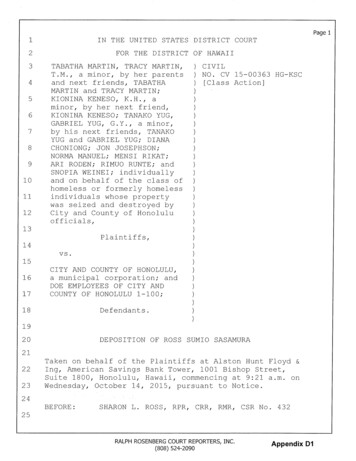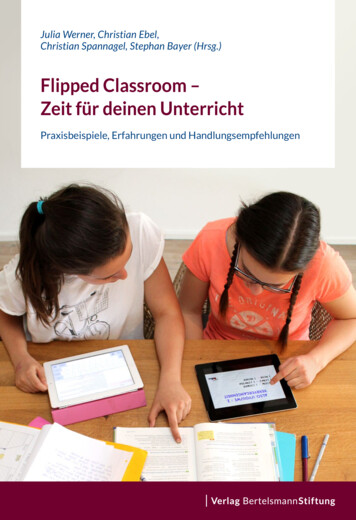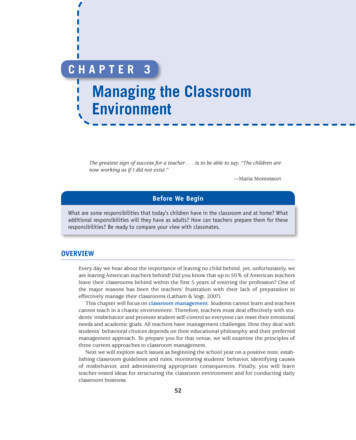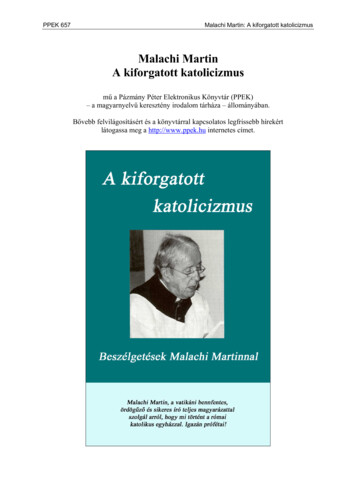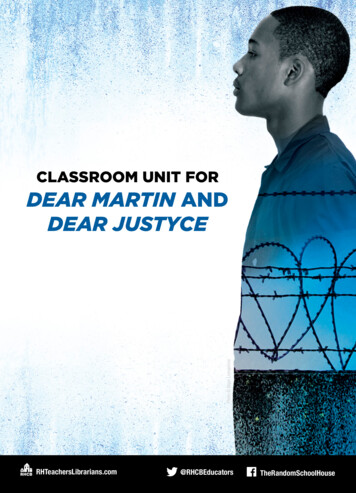
Transcription
CLASSROOM UNIT FORPhoto Nigel LivingstoneDEAR MARTIN ANDDEAR ndomSchoolHouse
Justyce McAllister is top of his class and set for the Ivy League—but none of that matters to the police officer who just put him inhandcuffs. And despite leaving his rough neighborhood behind,he can’t escape the scorn of his former peers or the ridicule of hisnew classmates.Justyce looks to the teachings of Dr. Martin Luther King Jr. foranswers. But do they hold up anymore? He starts a journal to Dr.King to find out. Then comes the day Justyce goes driving withhis best friend, Manny, windows rolled down, music turned up—way up—sparking the fury of a white off-duty cop beside them.Words fly. Shots are fired. Justyce and Manny are caught in thecrosshairs. In the media fallout, it’s Justyce who is under attack.Vernell LaQuan Banks and Justyce McAllister grew up a blockapart in the southwest Atlanta neighborhood of WynwoodHeights. Years later, though, Justyce walks the illustrious hallsof Yale University . . . and Quan sits behind bars at the FultonRegional Youth Detention Center.Nic Stone is an Atlanta native and a Spelman College graduate.After working extensively in teen mentoring and living in Israelfor several years, she returned to the United States to write fulltime. Nic’s debut novel for young adults, Dear Martin, was a #1New York Times bestseller and William C. Morris Award finalist.She is also the author of Odd One Out, a novel about discoveringoneself and who it is okay to love, which was an NPR Best Bookof the Year and a Rainbow Book List Top Ten selection, andJackpot, a love-ish story that takes a searing look at economicinequality which was a Seventeen and Paste Best YA Novel ofthe Year. The New York Times bestseller Clean Getaway, Nic’sfirst middle-grade novel, deals with coming to grips with thepain of the past and facing the humanity of our heroes. She livesin Atlanta with her adorable little family.Find her online at nicstone.info or on Instagram @nicstoneArt used under license by ShutterStock.comPhoto Nigel LivingstoneThrough a series of flashbacks, vignettes, and letters toJustyce—the protagonist of Dear Martin—Quan’s story takesform. Troubles at home and misunderstandings at school give riseto police encounters and tough decisions. But then there’s a deadcop and a weapon with Quan’s prints on it. What leads a brightkid down a road to a murder charge? Not even Quan is sure.
A LETTER FROM DR. JARRED AMATO,HIGH SCHOOL ENGLISH TEACHER AND PROJECT LIT COMMUNITY COFOUNDERWe know that great books, books like Dear Martin and Dear Justyce, have a unique ability to connectus and comfort us, to challenge us and change us. They help us make sense of our society and our placein it. We also know that great books like Dear Martin and Dear Justyce are being written for today’sstudents to read now, so thank you for doing your part to make that happen.However, if you’re looking for traditional comprehension questions to quiz students at the endof each chapter, you’ve come to the wrong place. The goal of this guide is to help classrooms andcommunities read and discuss Dear Martin and Dear Justyce together. It is a starting point, not the finishline. It is full of possibilities, but not a playbook. Our hope is that you take some of these ideas andactivities and make them your own. We’re so excited to see what everyone comes up with as we striveto better ourselves and the world around us.Put simply, books like Dear Martin and Dear Justyce are needed in our classrooms and curriculum.Just ask Jakaylia, a Project LIT founder and now college sophomore. She wrote:We encourage educators to do their homework before diving into the world of Justyce and Quan.Know your students. Know the books (that means taking time to read them before starting the unit).Know yourself. Know what your goals are, not just for Dear Martin and Dear Justyce, but for the quarter,for the semester, for the year.Whether you’re a first-year teacher (congrats!) or a thirty-year veteran (congrats!), take a momentto reflect. What other texts are you and your students reading and discussing? What came before DearMartin and Dear Justyce? What’s next? How do you build community in your classroom? How do youallow for student voice and choice? How do you ensure that all students feel safe, seen, heard, and valued?Again, we cannot wait for you and your students to read and discuss Dear Martin and Dear Justyce! Weare so excited to see the writing, conversation, and change that comes from it. Continue to listen to ouryoung people, and let them lead the way. Continue to do the work. Continue to connect and collaboratewith others, online and offline. Continue to block out the noise and provide all students with the positiveliteracy experiences they deserve, day in and day out. Continue to read, reflect, and resist.Happy reading,JarredArt used under license by ShutterStock.com“Being a part of Project LIT has given me the space and confidence to share my opinions with othersand listen to what they have to say. It’s helped me learn a lot about real-life issues and what we cando together to make a change. A lot of kids today don’t enjoy reading because they think it’s boringand, if we’re being real, they’re not wrong. A lot of the books students are forced to read in schoolare not relevant, interesting, or enjoyable. They’re out-of-date and out of touch with our lives. That’swhy Project LIT is so important. We’re showing kids and adults that books can be just as cool asTV shows, video games, and sports. Through Project LIT, we’ve had the opportunity to read someamazing books by authors who understand what it’s like to be a teenager today. One book that standsout is Dear Martin by Nic Stone. Nic is one of the most influential people in my life, and I am honoredto know her. She’s one of the sweetest and funniest people you’ll ever meet, but most important,she’s real. She’s not afraid to tell you how it is. She will tell you that your opinion always matters.She inspires all of us to be ourselves and reminds us that it’s okay to be different, to stand out.”
BEFORE READINGActivismJuvenile Justice SystemAdolescent Brain DevelopmentMasculinityCivil Rights MovementMass IncarcerationComplexities of Gang CultureMediaCriminal Justice ReformMental HealthDomestic ViolencePolice hool-to-Prison PipelineImplicit BiasSupport SystemsJusticeTrauma and PTSDArt used under license by ShutterStock.comWe encourage educators to continue their own internal work, reflecting on racial identities andclassroom practices, before diving into Dear Martin and Dear Justyce. What community norms andagreements do you already have in place regarding discussion in your classroom? Is there anything thatyou need to revise or revisit? What does discussion look like? Small group? Whole class? How do youencourage student reflection? How do you normally talk about race in your classroom? What texts haveyou read before Dear Martin and Dear Justyce? What texts do you plan to read next? What connectionscan students make between Dear Martin and Dear Justyce and other texts? Is this the right time tobegin the unit? If the answer is yes, we recommend that educators and students explore the followingtopics and themes before diving into the novel(s), whether it’s through a gallery walk, journal writing,anticipation guide, or something else.
ACTIVITIES FOR DURING AND AFTER READINGCHARACTERIZATION What adjectives would you use to describe each character (Quan, Justyce, Martel, SJ, Doc)? Whattraits or qualities does each possess? Be sure to provide evidence to support your answers! Trace the evolution of one or more characters (Justyce, Jared, Quan, SJ) throughout the novel(s). Create a playlist for a character or for each novel as a whole. Create a Twitter/Instagram/Facebook profile for one or more characters. Write an interview with one of the characters for the school newspaper. Create a text message conversation (or group chat) between characters.POETRY Write a bio poem from the point of view of a character in the novel(s). Create a haiku inspired by the novel(s). Find seven to ten words from the novel(s) that stand out and include them in a poem. Create an acrostic poem using anything related to the novels (titles, character names). Create blackout poetry inspired by the novel(s). Craft a two-voice poem, featuring Justyce and Quan, Justyce and SJ, or Justyce and Manny. Find poems that connect to the novels. Host a poetry slam inspired by Dear Martin and Dear Justyce.LETTERS Write a letter to a character in the novel, offering advice, commenting on a conflict they wentthrough, or sharing how you can relate. Write a letter to the author about what you took away from the book, how it changed yourthinking, its importance and impact, favorite scenes, favorite characters, why you enjoyed it, andwhy you’d recommend it to others. Write a letter from one character to another either continuing or extending the conversationsbetween Justyce and Quan or between other characters. Write a letter to a character’s younger or future self. Write a letter to someone in your life who is in need of encouragement. Write a letter to someone in your life who has always been in your corner. Write a letter to someone you consider to be heroic.Art used under license by ShutterStock.com Write a letter from a character’s past or future self.
PLOT AND POINT OF VIEW Rewrite a pivotal scene from either book. Rewrite a scene from a different character’s point of view. Turn a scene (or the entire novel!) into a movie script or play. Chart the major moments in each book (exposition, rising action, climax, falling action, resolution).SUMMARY AND CRITIQUE Create a six-word summary for each chapter, character, and book. Create a six-word critique for each chapter, character, and book. Create a book review that combines summary and critique. Share your review on a social mediaplatform of your choice. Create a movie trailer for the book(s).MORE PROMPTS AND IDEAS! Compare and contrast Dear Martin and Dear Justyce through art, video, essay, or poetry. Create a one-sheet that captures quotes, images, characters, themes, etc. from both books. Create artwork inspired by the novels (alternate book cover, character sketch, or collage, forexample). Trace a theme through the novel(s). Create a one-sheet at the end of a chapter, section, or book that explains your thoughts. Find five (or more) words from the novel(s) that were previously unknown to you or that you foundparticularly important. How does Nic Stone use dialogue in the story? What purpose does it serve? What does it reveal? Analyze Nic Stone’s technique and style. Pick a sentence from either book. What stood out to you about it, and why? Create new titles for each chapter.wondering or thinking about? Create a double-entry journal to reflect on key quotes and passages.Art used under license by ShutterStock.com What are some of the big questions that you have at different points in the novel? What are you
AFTER-READING ACTIVITIES, PROMPTS, AND PROJECTSSNAPSHOTSThere are twelve snapshots in Dear Justyce, including the final one, six months after the main action.What does the reader learn from these moments? What effect do they have on the novel? Afterrevisiting these snapshots, write your own for either Dear Martin or Dear Justyce. Or write a snapshotfrom your own life.LETTERSQuan writes nine letters to Justyce (along with a letter to his dad). What does he reveal in these letters?What impact do these letters have on Quan and Justyce? Trace Quan’s evolution over the course ofhis communication with Justyce. After revisiting these letters, write your own letters (from Justyce toQuan, Quan to Justyce, or yourself to Quan).WRITING PROMPTSWe hope that Dear Justyce inspires students to write stories and letters of their own. Here are someprompts that may work during or after reading the novel. How are you similar and different from Quan? Justyce? Write about a time when something changed. Write about one of your favorite childhood memories. Write about what you miss about being a “KID kid” (p. 70). Write about your neighborhood. Write about a time when you felt stuck or powerless. Write about your reaction to the Math Test, or a time you experienced something similar. Write about a teacher who believed (or didn’t believe) in you. Write about a place you feel safe (playground, library, basketball court). Write about a time when you’ve been misunderstood or underestimated. Write a poem that asks the question: What if . . . ? Write about your hopes and dreams. Write a letter to a friend or family member. Write about a time you felt like giving up. Write about a time when you’ve been in a catch-22 or no-win situation. Write a letter to your younger or future self.Art used under license by ShutterStock.com Write about your strengths and talents.
RESEARCH AND DISCUSSION QUESTIONS To borrow a prompt from Doc: How is the United States “currently failing to uphold the standardsset forth in its foundational documents”? (p. 40) Quan asks Justyce, “Why’d we turn out so different?” (p. 43) How would you answer thisquestion? Quan says, “When you’re in that like middle to high school range, the people you’re connectedto REALLY influence what you wind up doing” (p. 70). Why do you think this is the case? Whatarticles or research can you find about teenage brain development and the effects of peer pressure? We are told that for Quan, “There was no not noticing the number of brown faces that cameand stayed compared to the number of not-brown ones that came and left” (p. 80). Researchthe juvenile justice system and school-to-prison pipeline, and share what you learn with yourclassmates. Martel wrote “Black Power is giving power to people who have not had power to determine theirdestiny” (p. 89). Research Huey Newton and the Black Panther Party for Self-Defense. Why does Quan join the Black Jihad? More broadly, why do young people join gangs? Analyze the symbolism of the rocket ship and its significance in the novel. To borrow another prompt from Doc: “Write a compelling argumentative essay that eithersupports or refutes the continued use of Harper Lee’s To Kill a Mockingbird as a seminal text onAmerican racism” (p. 132). How does the “THE END/a short film” (pp. 118–125) connect to Monster by Walter Dean Myers? Read aloud the class scene (pp. 168–174), and write your own class discussion. Quan has a solid team of people in his corner—caseworker, therapist, teacher, and attorney.Which of these careers most interests you? Research what it takes to join that profession. Quan says, “Everyone should have somebody who believes in ’em. Like no matter what they’vedone. Somebody who won’t give up on them. . . . No strings attached” (p. 226). How do you feelabout this statement? Who do you believe in? Who believes in you? What connections can you make between Dear Martin, Dear Justyce, and other texts you haveread? Create a poster or brainstorm map to demonstrate connections. Select and analyze a podcast, film, documentary, TED Talk, or anything else that examines aArt used under license by ShutterStock.comtheme from Dear Martin or Dear Justyce.
Dr. Jarred Amato and the incredible students at Maplewood High School (Nashville, TN) foundedProject LIT in August 2016 with the goal of eliminating book deserts and promoting a love ofreading. Over the past four years, they have transformed a class project into a national grassrootsliteracy movement—one book, one conversation, one step at a time. From launching a book drive andsetting up LIT libraries across East Nashville to hosting a monthly community-wide book club andredesigning our literacy curriculum, they developed a model Project LIT “chapter,” where studentsare empowered daily as readers, writers, and leaders. By June 2017, they encouraged other schools tojoin the movement. As of June 2020, there are more than 1,500 Project LIT chapters across all fiftystates, and they’d love for you and your students to join! Follow @ProjectLITcomm on Twitter andInstagram for more information.Art used under license by ShutterStock.comABOUT PROJECT LIT
EXAMPLE PROJECT LIT BOOK CLUB PREPARATION for Dear Martin andDear Justyce Share at least five possible discussion questions for our book club. Now that you’ve read DearMartin and Dear Justyce, what would you like to talk about with your classmates? What’s on yourmind? Submit at least one piece of writing from our unit that you would like to share with Nic Stone! Go back to the text and create at least five questions (and answers) for our Dear Martin/DearJustyce trivia competition! What suggestions or ideas do you have for our book? How would you like to contribute?SAMPLE QUESTIONS FROM STUDENTS IN DR. AMATO’S CLASS Overall, what are your thoughts on Dear Martin? How did your emotions change from beginningto end? What characters could you most identify with or relate to, and why? What scene(s) and quotes stood out to you? What do you think you’ll most remember from thisbook? If you could change something about the book, what would it be? (Yeah, let’s talk about Manny.) How do you think Dr. King would feel about our country today? Why does racism still exist? Who would you write letters to for guidance, and why? (How do you normally cope with stressand anger?) What can we do to make our world better? How does Dear Martin compare to other books we’ve read with similar themes, such asAll American Boys and The Hate U Give? What questions would you like to ask Nic about the book and her experience writing it?AND PROJECT LIT CONTENT, PLEASE OMMArt used under license by ShutterStock.comFOR ADDITIONAL INFORMATION, RESOURCES,
TED TALKSINTERVIEWS“The Danger of Silence”by Clint Smithted.com/talks/clint smith the danger of silence?utmterm social-justice&utm campaign social&utmcontent talk&utm source t.co&utm medium referral“A Frank Conversation About YA Literature,Police Brutality,and the Nuances of Black Storytelling”by Nic Stone and Kim m-johnsonconversation/“How to Overcome Our Biases? Walk BoldlyToward Them”by Verna Myersted.com/talks/verna myers how to overcome ourbiases walk boldly toward them/transcript“How to Raise a Black Son in America”by Clint Smithted.com/talks/clint smith how to raise a black sonin america?language en“The Path to Ending Systemic Racism inAmerica”by Chris Anderson and Whitney PenningtonRodgersted.com/talks/dr phillip atiba goff rashad robinson drbernice king anthony d romero the path to endingsystemic racism in the us?referrer playlist-talks tohelp you understand r“We Need to Talk About an Injustice”by Bryan Stevensonted.com/talks/bryan stevenson we need to talk aboutan injustice?language en“3 Ways to Speak English”by Jamila Lyiscottted.com/talks/jamila lyiscott 3 ways to speak englishRESOURCESBlack Lives Matterblacklivesmatter.com/resources/Equal Justice Initiativehttps://eji.org/Facing Historyfacinghistory.orgTeaching Tolerancetolerance.orgThe 1619 /1619america-slavery.htmlGuide prepared by Dr. Jarred Amato,High school English teacher and Project LIT Community CofounderTrevor Noah Interviews Ibram X. Kendi andJason Reynoldsyoutube.com/watch?v 6D6Ge1VXySoTrevor Noah Interviews Jason ders-with—long-way-down“Why Teens Should Understand TheirOwn Brains (And Why Their TeachersShould, -whytheir-teachers-should-tOP-EDS“The Case for Reparations”by Ta-Nehisi -case-forreparations/361631/“Don’t Just Read About Racism—Read StoriesAbout Black People Living”by Nic 1/readblack-books-nic-stone/“Even When They’re Hunting Us, I Would StillChoose to Be Black Over and Over Again”by Tiffany D. eopleprotests-tiffany-jackson/“How to Make This Moment the Turning Pointfor Real Change”by Barack �Where Are the People of Color in Children’sBooks?”by Walter Dean 0 Things White People Can Do for RacialJustice”by Corinne -peoplecan-do-for-racial-justice-f2d18b0e0234Art used under license by ShutterStock.com“The Danger of a Single Story”by Chimamanda Ngozited.com/talks/chimamanda ngozi adichie the dangerof a single story?language en
ADDITIONAL TITLES BY NIC STONE!AN HONEST ANDTOUCHING DEPICTIONOF FRIENDSHIP, FIRSTLOVE, AND EVERYTHINGIN BETWEENH “A heartwarming, familycentered adventurethat will leave readersguessing until the end.”“For fans of authors whodig complex relationships,like Shannon M. Parker,Ashley Woodfolk andMisa Sugiura.”—Publishers Weekly,Starred ReviewH “An absolute firecrackerof a book anda must-have forchildren’s collections.”—Booklist,Starred Review“Rich in history, Stone’smiddle-grade debutentertains and informsyoung readers. . . .A road trip to remember.”—Kirkus Reviews“Stone has crafted ahistory lesson in road-tripform. . . . a good additionfor school libraries seekingunconventional approachesto history.”—Paste“Essential reading.”—Booklist“An important andnecessary love story.”—School Library Journal“Stone challengesstereotypical notionsof what it means to bestraight, bisexual, or gay,showing how sexualidentities and desires canbe as complicated as theindividual human brain.”A PITCH-PERFECTROMANCE THATEXAMINES CLASS,PRIVILEGE, AND HOWA STROKE OF GOODLUCK CAN CHANGEAN ENTIRE LIFE“A heartfelt, humorousteen romancefraught with tension. . . .Hard-to-put-down.”—Booklist“Stone delivers athoughtful and polishednovel about class, privilege,and relative poverty.”—Kirkus Reviews“Stone authenticallyportrays the precarious,terrifying act of living withfar less than is needed tosurvive, and its financialand emotional fallout.”—Publishers Weekly—Publishers Weekly—School Library ndomSchoolHouseArt used under license by ShutterStock.comA MIDDLE-GRADE ROADTRIP STORY THROUGHAMERICAN RACERELATIONS PASTAND PRESENT
time. Nic’s debut novel for young adults, Dear Martin, was a #1 New York Times bestseller and William C. Morris Award finalist. She is also the author of Odd One Out, a novel about discovering oneself and who it is okay to love, which was an NPR Best Book of the Year and a



